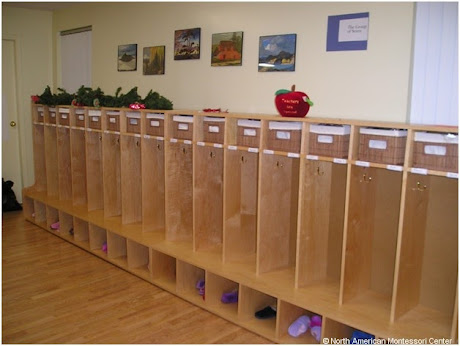
This all seems relatively easy to understand, but the first time I needed to order furniture for my Montessori environment, I panicked!
A Guide to Preschool/Kindergarten and Elementary Montessori Classroom Furniture
I had several catalogs to order from but when it came down to specifics, I had no idea what size tables and chairs I needed. All I knew was they had to be “child-size.” But children come in different sizes! There is a big difference between a young 3-year-old and an older 6-year-old. Luckily, I came across this handy Chair and Table Height Guidelines reference page from Community Playthings.

When choosing chairs, the most important thing to remember is that, when seated, the child’s feet should be flat on the floor. For children ages 3–6, it is suggested there be chairs 10–12 inches (about 25–30 cm) in height, while elementary-age children need chairs 12–16 inches (about 30–30 cm) in height. Because Montessori classrooms cover a three-year age range and children come in different sizes, it might be wise to have chairs of different sizes, covering the full range. Table tops should be about 8 inches (approximately 20 cm) from the top of the child’s legs to insure good posture and proper work habits.

Deciding what shelves to use can also be puzzling. For preschool classrooms, try to use shelves that are no more than 32 inches (about 81 cm) tall. Elementary classrooms may use shelves between 32 and 40 inches (approximately 81–101 cm) in height. Some units have fixed shelves that are permanently divided, but including units with adjustable shelves is useful to accommodate different size materials. Some shelves come with translucent backs, which allow for added light and visibility, while other shelves have solid backs. Others may also have no backs at all, which is useful for accessing materials from either side. I also like adding rounded or curved shelves on the ends of rectangular shelving. It gives the room a gentler feel by softening and rounding out the angles.

Coat racks and cubbies should all be hung at the child’s level. It is counterproductive to try to teach the child to hang up her coat when she cannot reach the hook! Similarly, a child cannot learn to be responsible for his work if he cannot reach into his cubby where the work is stored.

The only adult-size furniture I ever have in my classroom is my rocking chair that I use when reading to the children. Although it is adult size, the children are still welcome to use it. In fact, it is a popular chair that is frequented by readers almost all day. I occasionally find it being used by someone who is not feeling well. Because adult-size chairs do not fit under child-size tables, I usually sit on a child’s chair or kneel on the floor when working with a child at a table. Some teachers choose to sit on a small stool instead.

Teacher desks are not usually found in the Montessori classroom. Since it is the child’s space and our attention should be on the child, our own personal work area is not be delineated by a teacher’s desk. Since we are a community of learners, it is important that the teacher models her work habits alongside the child.
As much as possible, NAMC’s web blog reflects the Montessori curriculum as provided in its teacher training programs. We realize and respect that Montessori schools are unique and may vary their schedules and offerings in accordance with the needs of their individual communities. We hope that our readers will find our articles useful and inspiring as a contribution to the global Montessori community.
© North American Montessori Center - originally posted in its entirety at Montessori Teacher Training on Friday, August 9, 2013.
© North American Montessori Center - originally posted in its entirety at Montessori Teacher Training on Friday, August 9, 2013.

0 comments:
Post a Comment
Have questions or comments? Let us know what you thought about this article!
We appreciate feedback and love to discuss with our readers further.